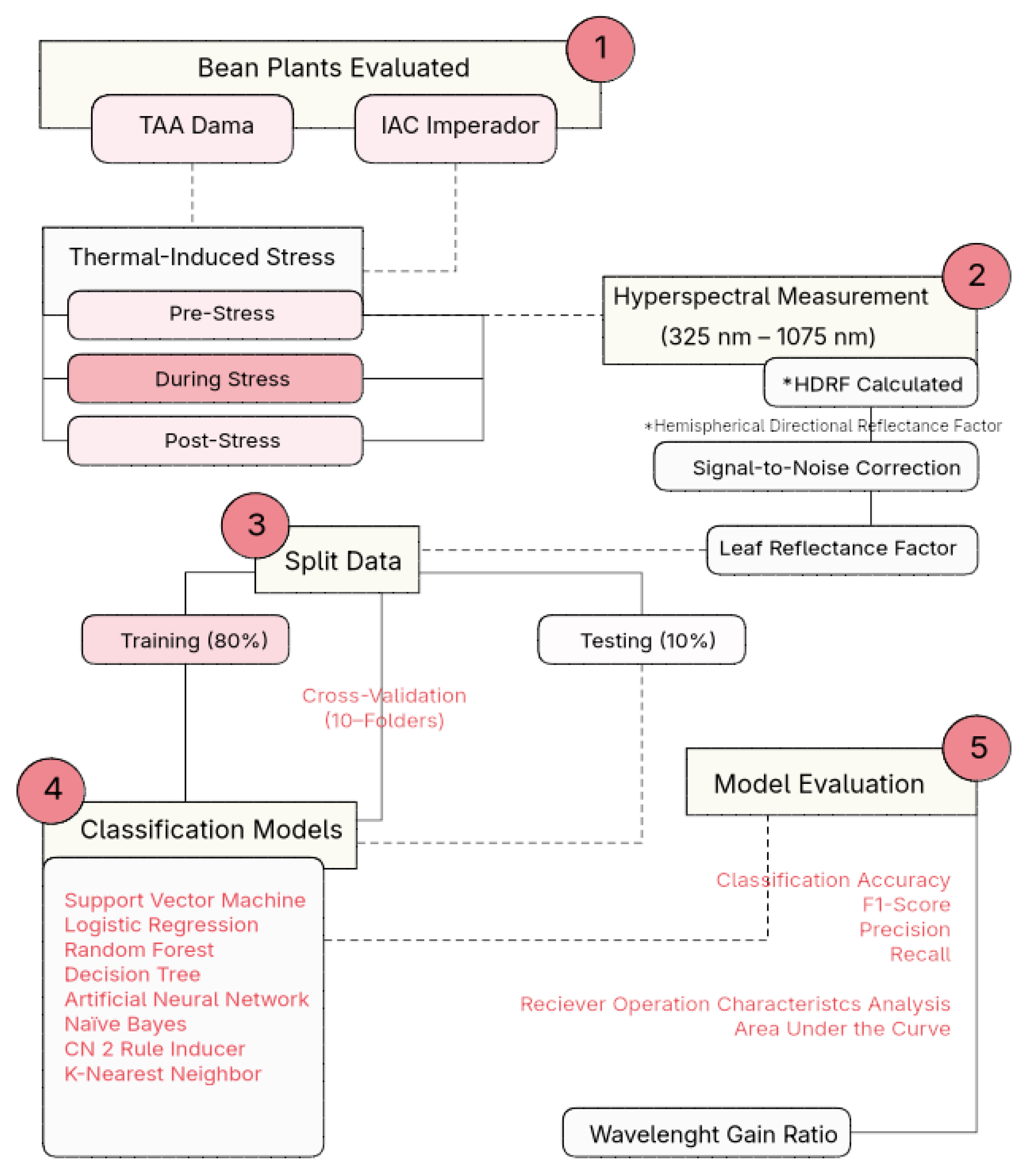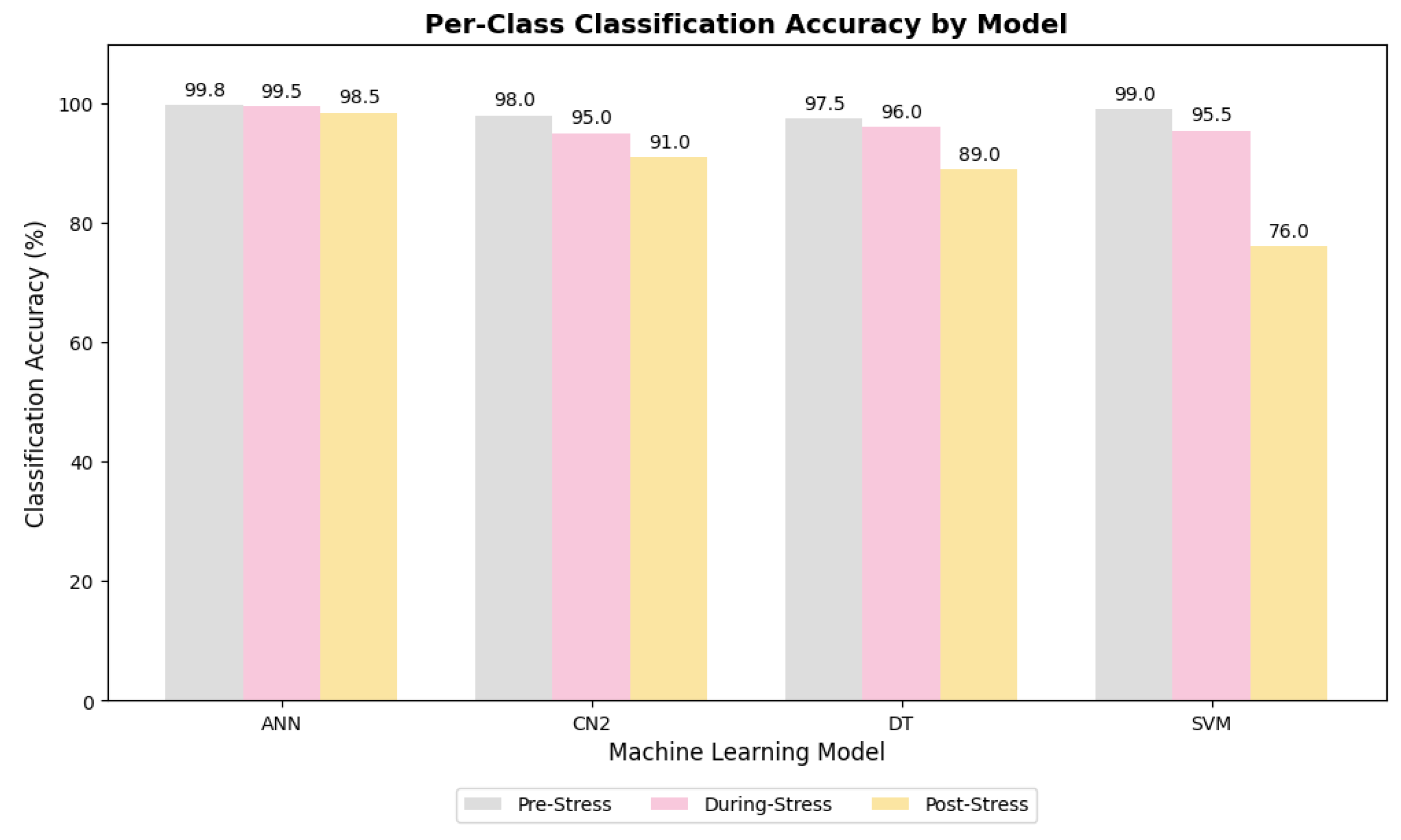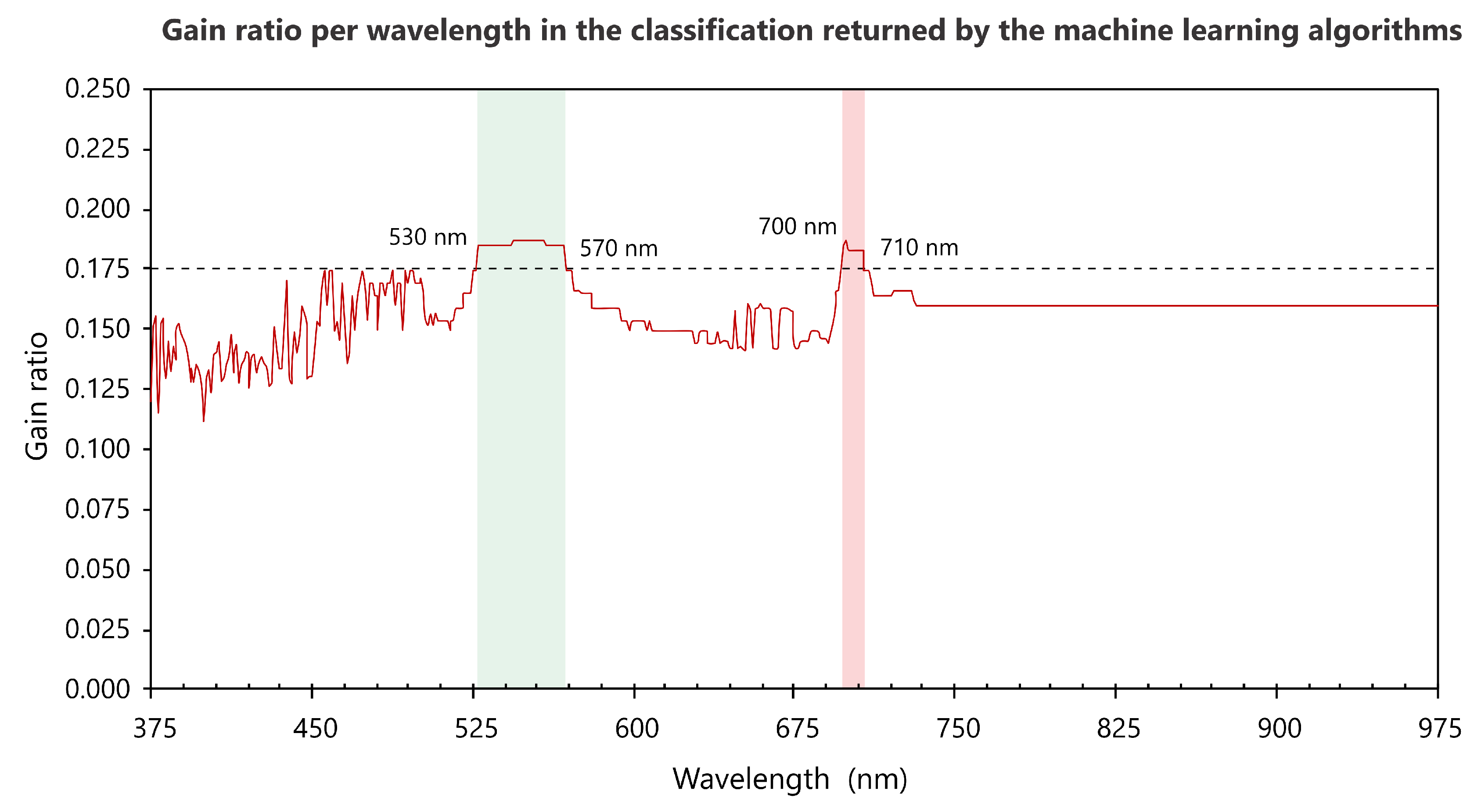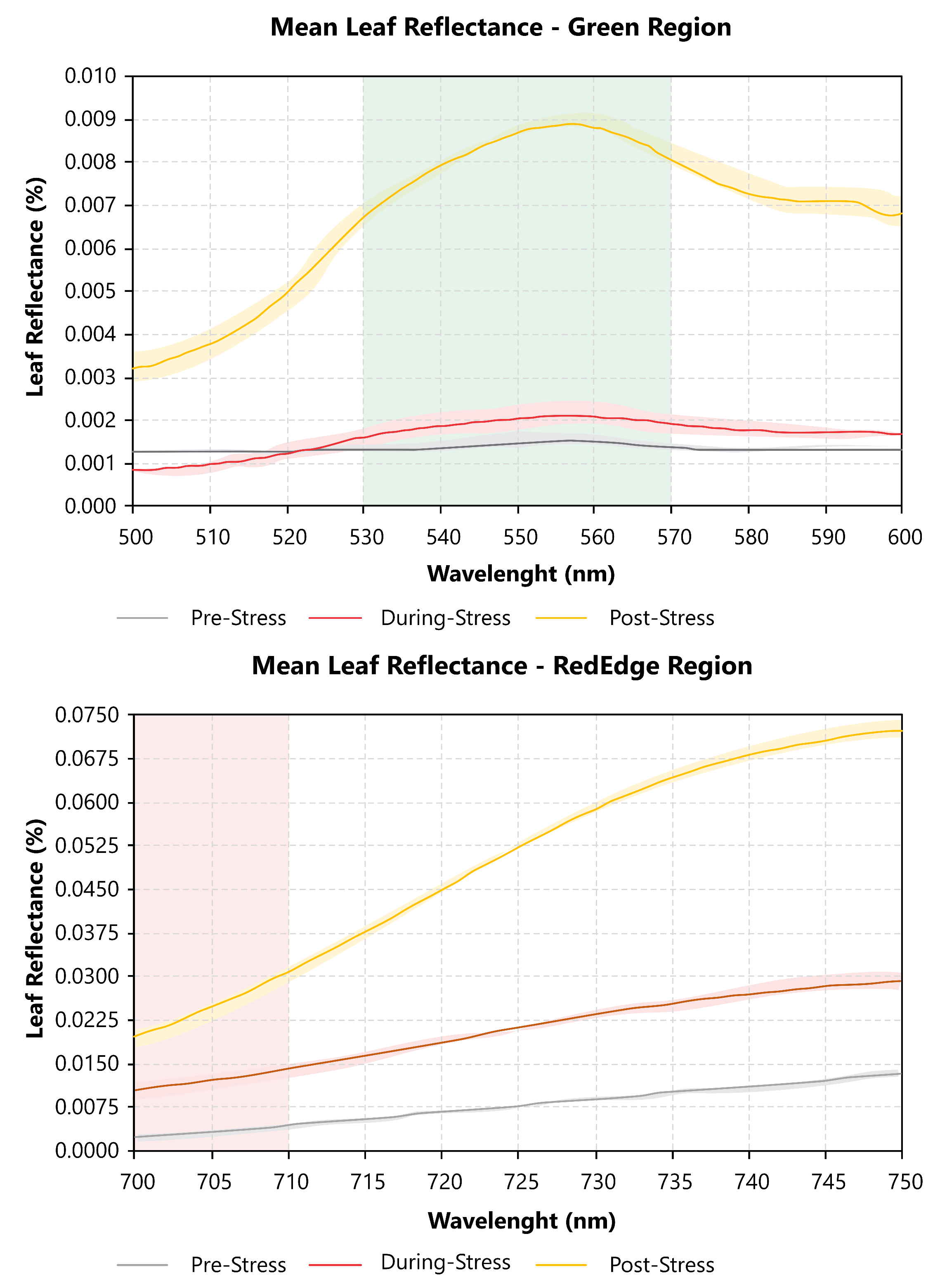A Machine Learning Framework for Classifying Thermal Stress in Bean Plants Using Hyperspectral Data
Abstract
1. Introduction
2. Materials and Methods
2.1. Experimental Setup
2.2. Spectral Measurement and Data Pre-Processing
2.3. Machine Learning Analysis
3. Results
3.1. Impact of Thermal Stress into Reflectance Measurements
3.2. Ranking the Contribution of Spectral Wavelengths
4. Discussion
5. Conclusions
Author Contributions
Funding
Data Availability Statement
Conflicts of Interest
References
- Letcher, T.M. Why do we have global warming? In Managing Global Warming; Elsevier: Amsterdam, The Netherlands, 2019; pp. 3–15. [Google Scholar]
- Moriarty, P.; Honnery, D. Global renewable energy resources and use in 2050. In Managing Global Warming; Elsevier: Amsterdam, The Netherlands, 2019; pp. 221–235. [Google Scholar]
- Badzmierowski, M.J.; McCall, D.S.; Evanylo, G. Using Hyperspectral and Multispectral Indices to Detect Water Stress for an Urban Turfgrass System. Agronomy 2019, 9, 439. [Google Scholar] [CrossRef]
- Cao, Z.; Yao, X.; Liu, H.; Liu, B.; Cheng, T.; Tian, Y.; Cao, W.; Zhu, Y. Comparison of the abilities of vegetation indices and photosynthetic parameters to detect heat stress in wheat. Agric. For. Meteorol. 2019, 265, 121–136. [Google Scholar] [CrossRef]
- Gerhards, M.; Schlerf, M.; Mallick, K.; Udelhoven, T. Challenges and Future Perspectives of Multi-/Hyperspectral Thermal Infrared Remote Sensing for Crop Water-Stress Detection: A Review. Remote Sens. 2019, 11, 1240. [Google Scholar] [CrossRef]
- Krishna, G.; Sahoo, R.N.; Singh, P.; Bajpai, V.; Patra, H.; Kumar, S.; Dandapani, R.; Gupta, V.K.; Viswanathan, C.; Ahmad, T.; et al. Comparison of various modelling approaches for water deficit stress monitoring in rice crop through hyperspectral remote sensing. Agric. Water Manag. 2019, 213, 231–244. [Google Scholar] [CrossRef]
- Egerer, M.H.; Lin, B.B.; Threlfall, C.G.; Kendal, D. Temperature variability influences urban garden plant richness and gardener water use behavior, but not planting decisions. Sci. Total Environ. 2019, 646, 111–120. [Google Scholar] [CrossRef] [PubMed]
- Khanna, R.; Schmid, L.; Walter, A.; Nieto, J.; Siegwart, R.; Liebisch, F. A spatio temporal spectral framework for plant stress phenotyping. Plant Methods 2019, 15, 1–18. [Google Scholar] [CrossRef] [PubMed]
- Maimaitiyiming, M.; Ghulam, A.; Bozzolo, A.; Wilkins, J.L.; Kwasniewski, M.T. Early Detection of Plant Physiological Responses to Different Levels of Water Stress Using Reflectance Spectroscopy. Remote Sens. 2017, 9, 745. [Google Scholar] [CrossRef]
- Karadağ, K.; Tenekeci, M.E.; Taşaltın, R.; Bilgili, A. Detection of pepper fusarium disease using machine learning algorithms based on spectral reflectance. Sustain. Comput. Inform. Syst. 2020, 28, 100299. [Google Scholar] [CrossRef]
- Abdullah, H.; Skidmore, A.K.; Darvishzadeh, R.; Heurich, M. Timing of red-edge and shortwave infrared reflectance critical for early stress detection induced by bark beetle (Ips typographus, L.) attack. Int. J. Appl. Earth Obs. Geoinf. 2019, 82, 101900. [Google Scholar] [CrossRef]
- Chen, J.; Li, F.; Wang, R.; Fan, Y.; Raza, M.A.; Liu, Q.; Wang, Z.; Cheng, Y.; Wu, X.; Yang, F.; et al. Estimation of nitrogen and carbon content from soybean leaf reflectance spectra using wavelet analysis under shade stress. Comput. Electron. Agric. 2019, 156, 482–489. [Google Scholar] [CrossRef]
- Sonobe, R.; Yamashita, H.; Mihara, H.; Morita, A.; Ikka, T. Hyperspectral reflectance sensing for quantifying leaf chlorophyll content in wasabi leaves using spectral pre-processing techniques and machine learning algorithms. Int. J. Remote Sens. 2021, 42, 1311–1329. [Google Scholar] [CrossRef]
- Zhou, W.; Zhang, J.; Zou, M.; Liu, X.; Du, X.; Wang, Q.; Liu, Y.; Liu, Y.; Li, J. Prediction of cadmium concentration in brown rice before harvest by hyperspectral remote sensing. Environ. Sci. Pollut. Res. 2018, 26, 1848–1856. [Google Scholar] [CrossRef] [PubMed]
- Rocha, A.D.; Groen, T.A.; Skidmore, A.K. Spatially-explicit modelling with support of hyperspectral data can improve prediction of plant traits. Remote Sens. Environ. 2019, 231, 111200. [Google Scholar] [CrossRef]
- Osco, L.P.; Ramos, A.P.M.; Moriya, É.A.S.; Bavaresco, L.G.; de Lima, B.C.; Estrabis, N.; Pereira, D.R.; Creste, J.E.; Júnior, J.M.; Gonçalves, W.N.; et al. Modeling Hyperspectral Response of Water-Stress Induced Lettuce Plants Using Artificial Neural Networks. Remote Sens. 2019, 11, 2797. [Google Scholar] [CrossRef]
- Virnodkar, S.S.; Pachghare, V.K.; Patil, V.C.; Jha, S.K. Remote sensing and machine learning for crop water stress determination in various crops: A critical review. Precis. Agric. 2020, 21, 1121–1155. [Google Scholar] [CrossRef]
- Feng, X.; Zhan, Y.; Wang, Q.; Yang, X.; Yu, C.; Wang, H.; Tang, Z.Y.; Jiang, D.; Peng, C.; He, Y. Hyperspectral imaging combined with machine learning as a tool to obtain high-throughput plant salt-stress phenotyping. Plant J. 2020, 101, 1448–1461. [Google Scholar] [CrossRef]
- Zhai, Y.; Cui, L.; Zhou, X.; Gao, Y.; Fei, T.; Gao, W. Estimation of nitrogen, phosphorus, and potassium contents in the leaves of different plants using laboratory-based visible and near-infrared reflectance spectroscopy: Comparison of partial least-square regression and support vector machine regression methods. Int. J. Remote Sens. 2012, 34, 2502–2518. [Google Scholar]
- Dmitriev, P.A.; Dmitrieva, A.A.; Kozlovsky, B.L. Random Reflectance: A new hyperspectral data preprocessing method for improving the accuracy of machine learning algorithms. AgriEngineering 2025, 7, 90. [Google Scholar] [CrossRef]
- Weinstein, B.G.; Marconi, S.; Bohlman, S.; Zare, A.; White, E. Individual Tree-Crown Detection in RGB Imagery Using Semi-Supervised Deep Learning Neural Networks. Remote Sens. 2019, 11, 1309. [Google Scholar] [CrossRef]
- Ahmed, N.; Mahmud, S.; Elahi, M.M.L.; Ahmed, S.; Sujauddin, M. Forecasting river sediment deposition through satellite image driven unsupervised machine learning techniques. Remote Sens. Appl. Soc. Environ. 2019, 13, 435–444. [Google Scholar] [CrossRef]
- Zhang, J.; Huang, Y.; Reddy, K.N.; Wang, B. Assessing crop damage from dicamba on non-dicamba-tolerant soybean by hyperspectral imaging through machine learning. Pest Manag. Sci. 2019, 75, 3260–3272. [Google Scholar] [CrossRef] [PubMed]
- Gao, J.; Meng, B.; Liang, T.; Feng, Q.; Ge, J.; Yin, J.; Wu, C.; Cui, X.; Hou, M.; Liu, J.; et al. Modeling alpine grassland forage phosphorus based on hyperspectral remote sensing and a multi-factor machine learning algorithm in the east of Tibetan Plateau, China. ISPRS J. Photogramm. Remote Sens. 2019, 147, 104–117. [Google Scholar] [CrossRef]
- Oliveira, A.K.d.S.; Rizzo, R.; Silva, C.A.A.C.; Ré, N.C.; Caron, M.L.; Fiorio, P.R. Prediction of corn leaf nitrogen content in a tropical region using Vis-NIR-SWIR spectroscopy. AgriEngineering 2024, 6, 4135–4153. [Google Scholar] [CrossRef]
- Osco, L.P.; Ramos, A.P.M.; Pereira, D.R.; Moriya, É.A.S.; Imai, N.N.; Matsubara, E.T.; Estrabis, N.; de Souza, M.; Junior, J.M.; Gonçalves, W.N.; et al. Predicting Canopy Nitrogen Content in Citrus-Trees Using Random Forest Algorithm Associated to Spectral Vegetation Indices from UAV-Imagery. Remote Sens. 2019, 11, 2925. [Google Scholar] [CrossRef]
- Loggenberg, K.; Strever, A.; Greyling, B.; Poona, N. Modelling Water Stress in a Shiraz Vineyard Using Hyperspectral Imaging and Machine Learning. Remote Sens. 2018, 10, 202. [Google Scholar] [CrossRef]
- Asaari, M.S.M.; Mertens, S.; Dhondt, S.; Inzé, D.; Wuyts, N.; Scheunders, P. Analysis of hyperspectral images for detection of drought stress and recovery in maize plants in a high-throughput phenotyping platform. Comput. Electron. Agric. 2019, 162, 749–758. [Google Scholar] [CrossRef]
- Elvanidi, A.; Katsoulas, N.; Ferentinos, K.P.; Bartzanas, T.; Kittas, C. Hyperspectral machine vision as a tool for water stress severity assessment in soilless tomato crop. Biosyst. Eng. 2018, 165, 25–35. [Google Scholar] [CrossRef]
- Gerhards, M.; Schlerf, M.; Rascher, U.; Udelhoven, T.; Juszczak, R.; Alberti, G.; Miglietta, F.; Inoue, Y. Analysis of Airborne Optical and Thermal Imagery for Detection of Water Stress Symptoms. Remote Sens. 2018, 10, 1139. [Google Scholar] [CrossRef]
- Huo, H.; Li, Z.-L.; Xing, Z. Temperature/emissivity separation using hyperspectral thermal infrared imagery and its potential for detecting the water content of plants. Int. J. Remote Sens. 2018, 40, 1672–1692. [Google Scholar] [CrossRef]
- Alves, V.C.D.; de Lima, S.F.; Santana, D.C.; Barreto, R.F.; da Cunha, R.A.; da Silva Cândido Seron, A.C.; Teodoro, L.P.R.; Teodoro, P.E.; de Cássia Félix Alvarez, R.; Campos, C.N.S.; et al. Predicting pineapple quality from hyperspectral data of plant parts applied to machine learning. AgriEngineering 2025, 7, 170. [Google Scholar] [CrossRef]
- Mahmud, M.S.; Zahid, A.; Das, A.K.; Muzammil, M.; Khan, M.U.; Tran, D.H.; Chang, Y.K. Trends and Prospect of Machine Vision Technology for Stresses and Diseases Detection in Precision Agriculture. AgriEngineering 2023, 5, 20–39. [Google Scholar]
- Marques Ramos, A.P.; Prado Osco, L.; Elis Garcia Furuya, D.; Nunes Gonçalves, W.; Cordeiro Santana, D.; Pereira Ribeiro Teodoro, L.; Antonio da Silva Junior, C.; Fernando Capristo-Silva, G.; Li, J.; Henrique Rojo Baio, F.; et al. A random forest ranking approach to predict yield in maize with uav-based vegetation spectral indices. Comput. Electron. Agric. 2020, 178, 105791. [Google Scholar] [CrossRef]
- Anderson, K.; Rossini, M.; Pacheco-Labrador, J.; Balzarolo, M.; Mac Arthur, A.; Fava, F.; Julitta, T.; Vescovo, L. Inter-comparison of hemispherical conical reflectance factors (HCRF) measured with four fibre-based spectrometers. Opt. Express 2013, 21, 605. [Google Scholar] [CrossRef] [PubMed]
- Lavrac, N.; Flach, P.A.; Kasek, B.; Todorovski, L. Rule induction for subgroup discovery with CN2-SD. In Proceedings of the ECML/PKDD’02 Workshop on Integration and Collaboration Aspects of Data Mining, Decision Support and Meta-Learning, Helsinki, Finland, 19 August 2002; pp. 77–87. [Google Scholar]
- Marrs, J.; Ni-Meister, W. Machine Learning Techniques for Tree Species Classification Using Co-Registered LiDAR and Hyperspectral Data. Remote Sens. 2019, 11, 819. [Google Scholar] [CrossRef]
- Abdulridha, J.; Batuman, O.; Ampatzidis, Y. UAV-Based Remote Sensing Technique to Detect Citrus Canker Disease Utilizing Hyperspectral Imaging and Machine Learning. Remote Sens. 2019, 11, 1373. [Google Scholar] [CrossRef]
- Pourghasemi, H.; Gayen, A.; Park, S.; Lee, C.-W.; Lee, S. Assessment of Landslide-Prone Areas and Their Zonation Using Logistic Regression, LogitBoost, and NaïveBayes Machine-Learning Algorithms. Sustainability 2018, 10, 3697. [Google Scholar] [CrossRef]
- Ghorbanzadeh, O.; Blaschke, T.; Gholamnia, K.; Meena, S.; Tiede, D.; Aryal, J. Evaluation of Different Machine Learning Methods and Deep-Learning Convolutional Neural Networks for Landslide Detection. Remote Sens. 2019, 11, 196. [Google Scholar] [CrossRef]
- Jamil, A.; Bayram, B. The delineation of tea gardens from high resolution digital orthoimages using mean-shift and supervised machine learning methods. Geocarto Int. 2019, 36, 758–772. [Google Scholar] [CrossRef]
- Feng, P.; Wang, B.; Liu, D.L.; Yu, Q. Machine learning-based integration of remotely-sensed drought factors can improve the estimation of agricultural drought in South-Eastern Australia. Agric. Syst. 2019, 173, 303–316. [Google Scholar] [CrossRef]
- Liang, L.; Di, L.; Huang, T.; Wang, J.; Lin, L.; Wang, L.; Yang, M. Estimation of Leaf Nitrogen Content in Wheat Using New Hyperspectral Indices and a Random Forest Regression Algorithm. Remote Sens. 2018, 10, 1940. [Google Scholar] [CrossRef]
- Ma, L.; Liu, Y.; Zhang, X.; Ye, Y.; Yin, G.; Johnson, B.A. Deep learning in remote sensing applications: A meta-analysis and review. ISPRS J. Photogramm. Remote Sens. 2019, 152, 166–177. [Google Scholar] [CrossRef]
- Furuya, D.E.G.; Ma, L.; Pinheiro, M.M.F.; Gomes, F.D.G.; Gonçalvez, W.N.; Junior, J.M.; Rodrigues, D.d.C.; Blassioli-Moraes, M.C.; Michereff, M.F.F.; Borges, M.; et al. Prediction of insect-herbivory-damage and insect-type attack in maize plants using hyperspectral data. Int. J. Appl. Earth Obs. Geoinf. 2021, 105, 102608. [Google Scholar]
- Osco, L.P.; Ramos, A.P.M.; Pinheiro, M.M.F.; Moriya, É.A.S.; Imai, N.N.; Estrabis, N.; de Araújo, F.F.; Liesenberg, V.; Jorge, L.A.d.C.; Li, J.; et al. A Machine Learning Framework to Predict Nutrient Content in Valencia-Orange Leaf Hyperspectral Measurements. Remote Sens. 2020, 12, 906. [Google Scholar] [CrossRef]
- Ramos, A.P.M.; Gomes, F.D.G.; Pinheiro, M.M.F.; Furuya, D.E.G.; Gonçalvez, W.N.; Junior, J.M.; Michereff, M.F.F.; Blassioli-Moraes, M.C.; Borges, M.; Alaumann, R.A.; et al. Detecting the attack of the fall armyworm (Spodoptera frugiperda) in cotton plants with machine learning and spectral measurements. Precis. Agric. 2022, 23, 470–491. [Google Scholar] [CrossRef]
- Ballester, C.; Brinkhoff, J.; Quayle, W.C.; Hornbuckle, J. Monitoring the Effects of Water Stress in Cotton using the Green Red Vegetation Index and Red Edge Ratio. Remote Sens. 2019, 11, 873. [Google Scholar] [CrossRef]
- Jensen, J.R. Remote Sensing of the Environment: An Earth Resource Perspective, 2nd ed.; Prentice Hall: Harlow, UK, 2014; pp. 333–378. [Google Scholar]
- Jiang, C.; Chen, Y.; Wu, H.; Li, W.; Zhou, H.; Bo, Y.; Shao, H.; Song, S.; Puttonen, E.; Hyyppä, J. Study of a High Spectral Resolution Hyperspectral LiDAR in Vegetation Red Edge Parameters Extraction. Remote Sens. 2019, 11, 2007. [Google Scholar] [CrossRef]
- Poona, N.K.; Ismail, R. Developing optimized spectral indices using machine learning to model Fusarium circinatum stress in Pinus radiata seedlings. J. Appl. Remote Sens. 2019, 13, 1. [Google Scholar] [CrossRef]
- Zhu, H.; Lin, C.; Dong, Z.; Xu, J.L.; He, Y. Early Yield Prediction of Oilseed Rape Using UAV-Based Hyperspectral Imaging Combined with Machine Learning Algorithms. Agriculture 2025, 15, 1100. [Google Scholar] [CrossRef]
- Zhu, H.; Lin, C.; Liu, G.; Wang, D.; Qin, S.; Li, A.; He, Y. Intelligent agriculture: Deep learning in UAV-based remote sensing imagery for crop diseases and pests detection. Front. Plant Sci. 2024, 15, 1435016. [Google Scholar] [CrossRef]
- Verkhoturov, A.L.; Stepanov, A.S.; Illarionova, L.V. Using radar data to monitor the condition of agricultural crops in the southern Russian Far East. Inform. Autom. 2024, 23, 1221–1245. [Google Scholar]






| Algorithm | Hyperparameter | Criteria |
|---|---|---|
| CN2 | Rule Ordered Measurement: Laplace Accuracy | Beam = 4 Rule Coverage (minimum) = 5 Rule Length (maximum) = 10 |
| kNN | Euclidean Distance | k-Neighbours = 5 |
| LR | Regularisation Strength | Ridge (L2) C = 1 |
| NB | None | None |
| ANN | Activation Linear Adam Solver Regularisation a = 0.0001 | Neurons (Hidden Layer) = 512 Number of Hidden Layers = 2 Epochs = 200 |
| SVM | Radial Basis Function (RBF) Kernel exp(−g |x−y|2) g = automatic SVM Type Cost = 1 Regression Loss = 50.00 | Tolerance = 0.0010 Interaction (limit) = 500 |
| RF | Number of Trees Nodes | Trees = 200 Nodes (maximum) = 5 |
| DT | Number of Leaves Trees depth | Leaves (minimal) = 2 Tree-depth (maximum) = 100 |
| Algorithm | OA (%) | F1-Score (%) | Precision (%) | Recall (%) | Specificity (%) |
|---|---|---|---|---|---|
| CN2 | 94.77 | 94.78 | 94.90 | 94.70 | 97.20 |
| kNN | 87.20 | 87.01 | 88.20 | 87.20 | 93.30 |
| LR | 59.30 | 55.16 | 61.40 | 59.30 | 80.90 |
| NB | 63.37 | 61.46 | 66.70 | 63.40 | 81.60 |
| ANN | 99.42 | 99.42 | 99.40 | 99.40 | 99.70 |
| RF | 65.70 | 63.21 | 73.30 | 65.70 | 83.10 |
| SVM | 90.11 | 90.01 | 91.70 | 90.10 | 95.60 |
| DT | 93.60 | 93.64 | 93.80 | 93.60 | 97.00 |
Disclaimer/Publisher’s Note: The statements, opinions and data contained in all publications are solely those of the individual author(s) and contributor(s) and not of MDPI and/or the editor(s). MDPI and/or the editor(s) disclaim responsibility for any injury to people or property resulting from any ideas, methods, instructions or products referred to in the content. |
© 2025 by the authors. Licensee MDPI, Basel, Switzerland. This article is an open access article distributed under the terms and conditions of the Creative Commons Attribution (CC BY) license (https://creativecommons.org/licenses/by/4.0/).
Share and Cite
Osco, L.P.; Moriya, É.A.S.; de Lima, B.C.; Ramos, A.P.M.; Júnior, J.M.; Gonçalves, W.N.; Jorge, L.A.d.C.; Liesenberg, V.; Li, J.; de Araújo, A.S.F.; et al. A Machine Learning Framework for Classifying Thermal Stress in Bean Plants Using Hyperspectral Data. AgriEngineering 2025, 7, 376. https://doi.org/10.3390/agriengineering7110376
Osco LP, Moriya ÉAS, de Lima BC, Ramos APM, Júnior JM, Gonçalves WN, Jorge LAdC, Liesenberg V, Li J, de Araújo ASF, et al. A Machine Learning Framework for Classifying Thermal Stress in Bean Plants Using Hyperspectral Data. AgriEngineering. 2025; 7(11):376. https://doi.org/10.3390/agriengineering7110376
Chicago/Turabian StyleOsco, Lucas Prado, Érika Akemi Saito Moriya, Bruna Coelho de Lima, Ana Paula Marques Ramos, José Marcato Júnior, Wesley Nunes Gonçalves, Lúcio André de Castro Jorge, Veraldo Liesenberg, Jonathan Li, Ademir Sérgio Ferreira de Araújo, and et al. 2025. "A Machine Learning Framework for Classifying Thermal Stress in Bean Plants Using Hyperspectral Data" AgriEngineering 7, no. 11: 376. https://doi.org/10.3390/agriengineering7110376
APA StyleOsco, L. P., Moriya, É. A. S., de Lima, B. C., Ramos, A. P. M., Júnior, J. M., Gonçalves, W. N., Jorge, L. A. d. C., Liesenberg, V., Li, J., de Araújo, A. S. F., Imai, N. N., & de Araújo, F. F. (2025). A Machine Learning Framework for Classifying Thermal Stress in Bean Plants Using Hyperspectral Data. AgriEngineering, 7(11), 376. https://doi.org/10.3390/agriengineering7110376










